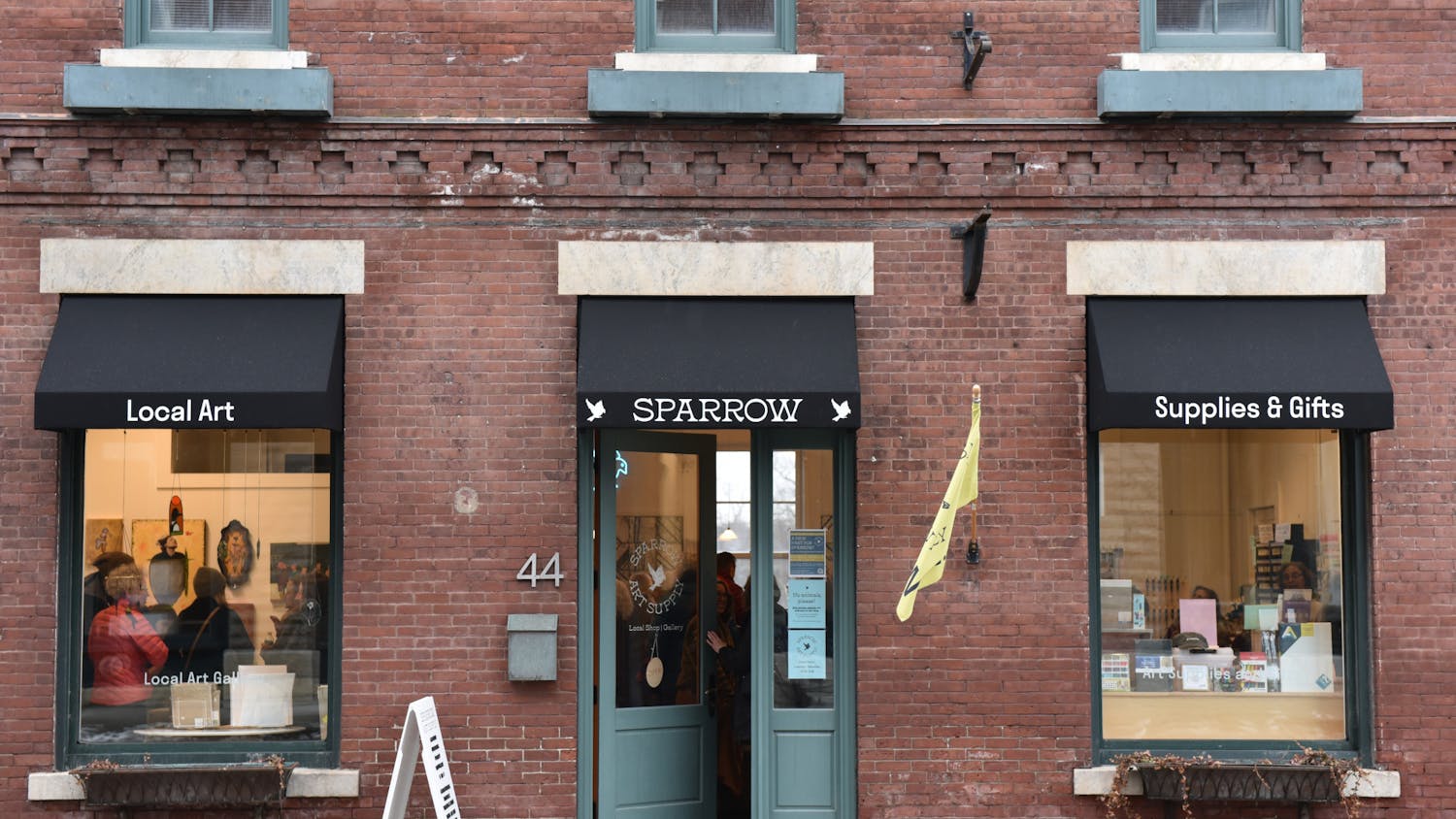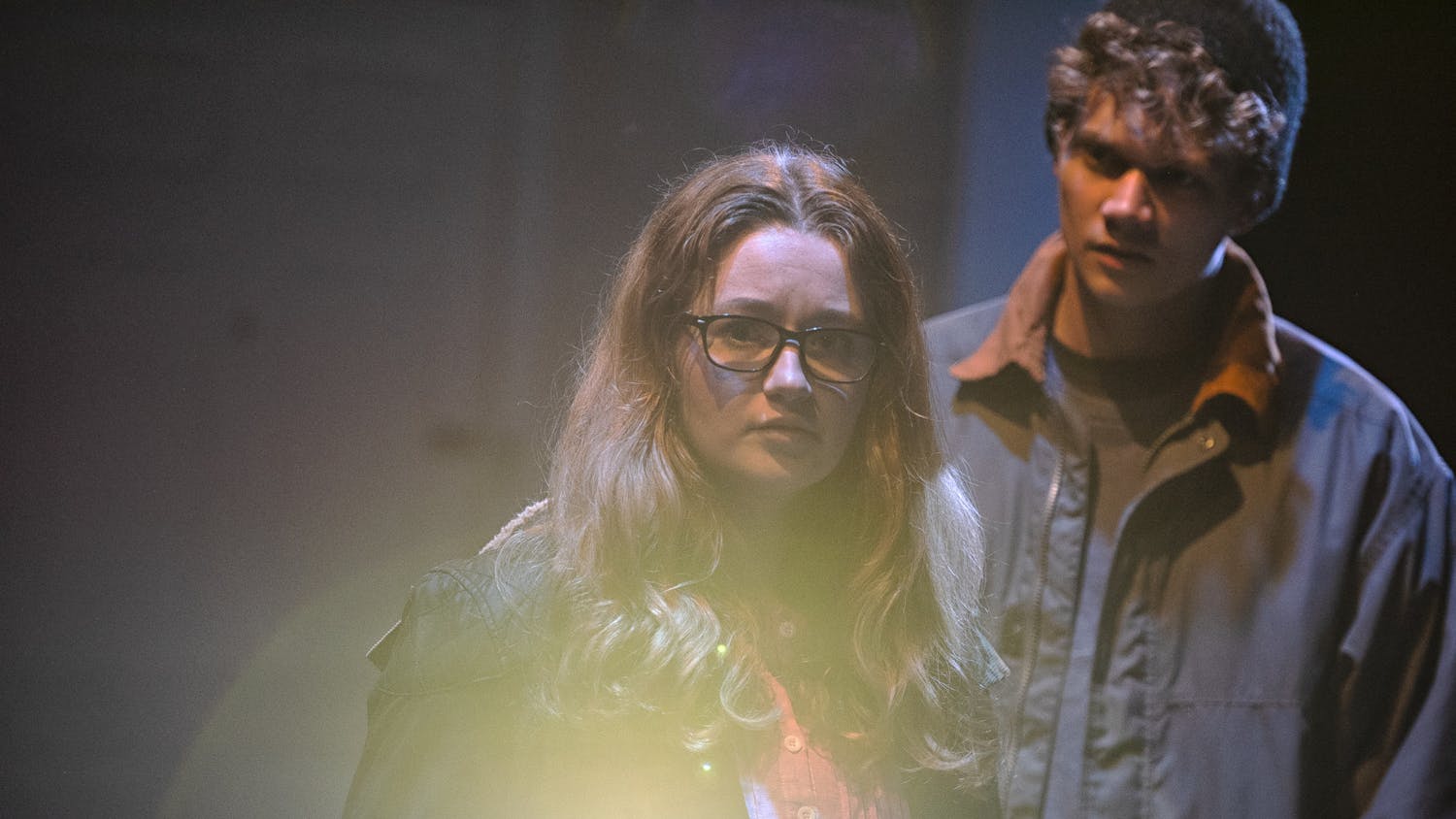The Department of Theatre and Dance presented an ambitious, large scale production of David Edgar’s Pentecost, an enviably clever play combining high art and international relations in an exhilarating exploration of culture and the past and present value of art on Nov. 21-23.
Edgar, one of the most prolific playwrights of the post-1960s British generation, wrote Pentecost in 1994 as part of a trilogy of plays discussing negotiation in Eastern Europe.
“I wanted to posit a different way of looking at culture, a model which acknowledged that all cultures are fundamentally hybrids, which grow and develop in response not just to the urge for continuity but the exigencies of change,” Edgar is quoted as saying in the program.
In the first act, the audience was welcomed into an unidentified Eastern European country, shortly after the fall of the Berlin Wall, as national art curator Gabrielle Pecs, played by Tosca Giustini ’15, and proper British art historian Dr. Oliver Davenport, portrayed by professional actor Jeffries Thaiss, discussed Pecs’ belief that she had discovered a piece of art that could elevate her small, unnoticed country onto the world stage and completely alter European art history.
The painting was gradually revealed through a series of complex and masterful set manipulations; at first only visible through the removal of a few bricks, it was then completely covered for most of the first act as it was prepared for removal and restoration.
Edgar established the multiplicity of language from the start with Pecs and Davenport discussing colloquialisms alone before being joined by a confident and often humorous cast of supporting characters who revealed – in multiple, sometimes overlapping languages – their own, often selfish, reasons for wanting the painting’s preservation or removal.
Thaiss and Giustini set the tone of the play from their first enigmatic lines, Giustini overflowing with energy as she masterfully delivered copious amounts of dialogue in an Eastern European accent.
Halfway through the first act, Assistant Professor of Theatre Alex Draper lit up the stage as stereotypical ‘arrogant American’ art historian Leo Katz, carrying an equal amount of confidence and assumption to ferociously deny that a work of any importance could be found in such an ‘insignificant’ country. What ensued in the remainder of the act was an engaging battle about the painting’s identity, removal from the church and final destination.
Professor of Theatre and director Richard Romagnoli explained that the investigation and exploration of the painting was his main reason for choosing the play.
“The significance of the painting is very moving and cathartic for me,” he said. “I’m hoping that audiences found one way or another into the play, but I think the weight of the painting itself is one way that could be useful for everyone.”
Throughout the play, 12 languages were spoken, giving the audience a true sense of what it feels like not to fully understand, often having to guess from body language, just like the English-speakers on stage, what a character was saying.
Draper noted that the dialogue proved to be one of the most difficult parts of the play.
“There’s a script, but just like in music, not all of it is played at the same volume or focus,” Draper said. “We had to figure out, if four people are talking at once, which happens a lot, what dialogue the audience needed to hear as the featured solo and what was backup.”
Just as the audience started to feel comfortable with the complex debate surrounding the painting, Edgar hit the audience with a shocker at the end of the first act. Katz, Pecs and Davenport were suddenly taken hostage as a multi-cultural group of refugees seeking political asylum burst into the church and demanded entrance into the countries of their choice.
Draper beautifully portrayed Katz’s remarkable and subtle personal transformation, ultimately handling the stressful situation much better than the usually calm and understanding Davenport, who nervously requests insulin for his diabetes and only intensifies the situation by infuriating Yasmin, the refugee leader played by Mari Vial-Golden ’14.
As the refugees realized that the painting on the wall may be even more valuable than their human prisoners, their individual stories came out. Full of pain, misery and in some cases, hope, the stories sparked sympathy in the hostages and the audience, despite constant threats of violence and ever present weaponry. The refugees interpreted each other’s folk tales and made music, showing that they were really not that different from their hostages, even as they threatened the painting and their prisoners.
Draper was moved both by the actors around him and the transformation of his character.
“The last ten days of the rehearsal and through the performance, somebody else would just floor me at a different time in the play,” Draper said. “In the performance, the actual stories of individual refugees for me, Leo Katz, became a whole lot more substantial and weighty than I had originally realized.”
Indeed, each actor embodied their character so strongly that I honestly forgot I was watching a play.
“Those who auditioned were just the best – they were curious, they were eager, questioning, tentative and reticent,” said Romagnoli. “They began to embrace the work so thoroughly and entirely while not losing the sense of reticence, but having enough confidence as a company that they were doing the right thing as an individual in the context of the collective. The student’s capacity to rise to the challenge and meet it so totally is what it’s really about.”
Part of what made Pentecost so impressive was the sheer size of the cast. The group, one of the largest companies in theatre department history, consisted of 28 students, professors and professional actors, as well as many professional crew members including a fight director and scenic painter.
Romagnoli and Draper sang the praises of the collaboration between professional and student actors.
“It’s a great combination,” Romagnoli said. “The professional actors are a great influence by example because they are the embodiment, with respect to their talent and their career journey, of where many of the students who wish to pursue acting can be. It’s one thing to be taught by a professional actor in an acting class, but that same person in a production teaches very differently and the whole educational process is much more intuitive and inductive.”
Draper agreed that the rehearsal process is an invaluable tool to all involved.
“The students will try our suggestions right away, and in that way, the adults need to remain students,” Draper said. “At the same time, the students need to be always learning to be proactive and at certain times to fight for what they think is the right thing to be doing in that moment because there comes a time when the actor knows more about their character than the director.”
Unlike many other theatre department productions, Pentecost boasted a heavy representation of the abundant international community on campus, and only two of the characters in the play are native English speakers.
Anis Mebarki ’15, who played Raif, an Azeri refugee, is from Algeria and speaks seven languages. Mebarki chose to act in Pentecost because it spoke to a part of his religious identity in practice and theory.
“The idea of the politics of asylum and migration and civil war is a very significant part of my family’s identity,” Mebarki said.
Mebarki went on to say that Pentecost holds a unique relevance with political and historical education for the whole community.
“One of the students at the lunch preview said ‘So, how was it for you to be part of a play that exhibits a sort of reality that is so distant from what we as Middlebury students know and do and experience?’ and I said, ‘No, there are a lot of people at the College, including myself, who did witness a sort of post-Socialist transition, at the end of the Cold War a transition into civil wars and the like, and I know for a fact that there are others,’” Mebarki said. “I think Pentecost helps make it a more pertinent reality for the audience members, and I was frankly just surprised that people assumed that we all come from this shared, safe, sheltered experience which is not the background we all had.”
The problem, as the play escalated to its finish, was that only four of the refugees were eventually given offers of freedom. The hostages were clearly moved by this denial of the refugees, and by this point, the audience was too, watching on the edge of their seats as the refugees became understandably angry.
The truly moving scene in the play came as a shock. Yasmin moved to torch the painting when suddenly, loud sirens sounded and three commandos broke through the wall of the church, forever destroying the painting, then opening fire as the theater got pitch dark. Each shot of the machine guns pierced through the dark, sparks illuminating tiny spaces on stage as screams rang out and the loud sounds of violence echoed heavily through the space.
As the lights turned back on, Pecs, Katz and the audience had to swallow the fact that the refugees were subject to unspeakable violence when they, despite their threats, never harmed anyone or anything.
Part of Pentecost’s complex message is that so much can be lost in translation, whether it be in a simple conversation, the verification of a painting’s identity or a life-or-death hostage situation. Katz and Davenport must learn how to survive in a situation where English is not the primary language, and Edgar uses his own artistic expression to convey that art has a unique and profound power to unite and divide.
Starting with a fascinating script, Romagnoli, Draper and every other member of the cast and crew crafted a thought-provoking, riveting production through strong individual efforts and a rare collective cohesion, creating a play that will last in the minds of the audience well into the future.
Languages Evoke Emotions in ‘Pentecost’

Comments



